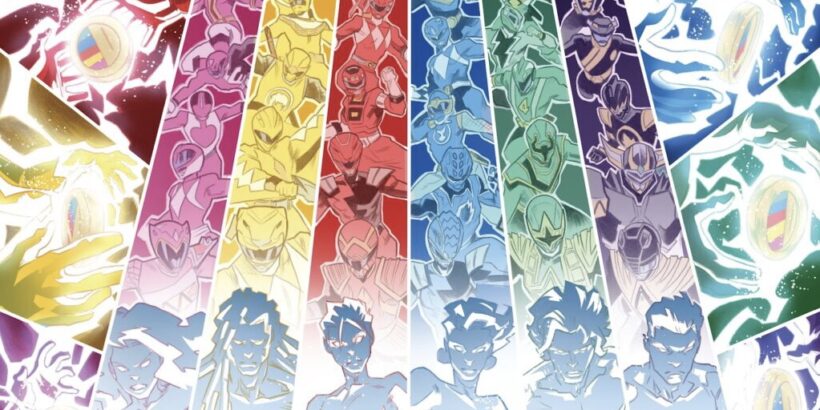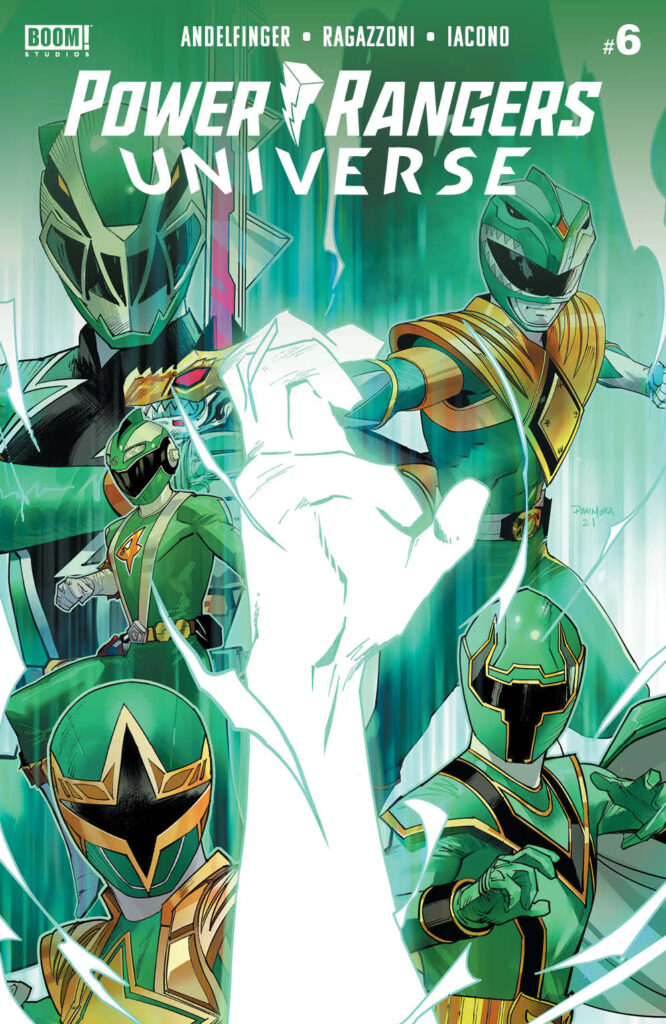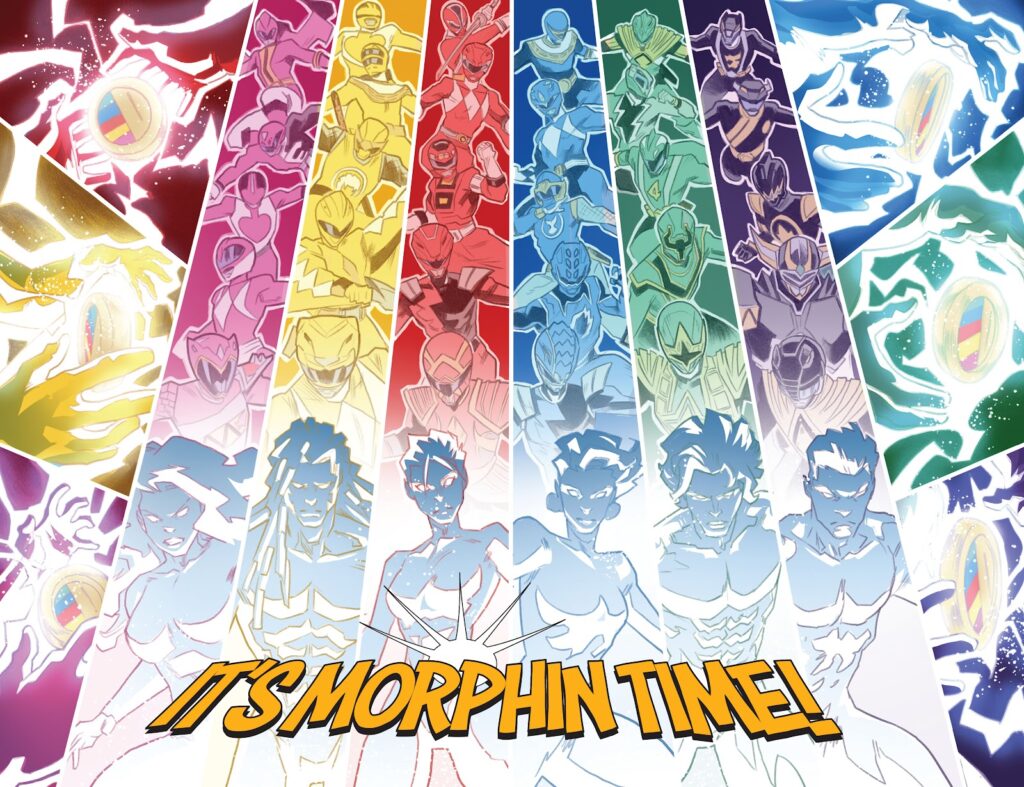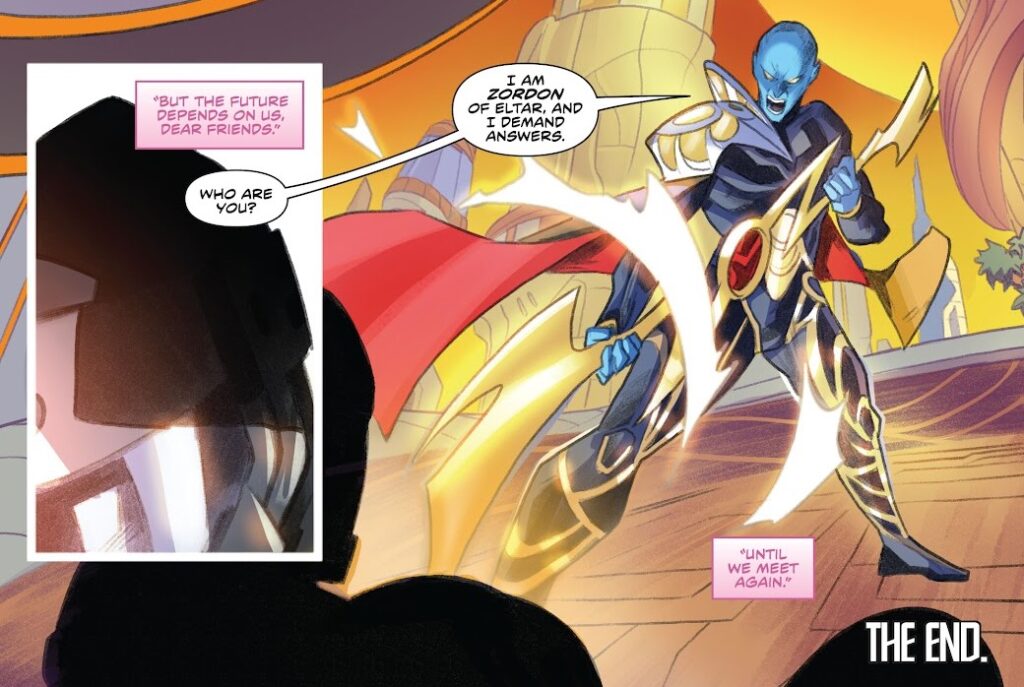
(Disclaimer: Please buy the comic before reading this review available at your local comic shop!)
They can also be found by visiting findacomicshop.com or comicshoplocator.com
Preface
At the beginning of this series, I talked about the state of the Power Rangers franchise and how it was in a state of limbo. 5 months later and we still don’t know what’s going on.
A lot of rumors about what’s coming for the 30th anniversary next year and none of them are substantial enough to get any response from me. (And the rumors are even more in chaos due to a certain “event” that happened last week…) And the news that we have gotten recently are mainly merchandise news of MMPR that aren’t worth a lot of time. *cough* Pinata *cough*
So, what is my response to all of this?
Be like this series. Just go with the flow. Focus on the story now and stop worrying about what’s coming next.
The Cover
Same thoughts as Power Rangers Universe #1’s cover. Love the energy swirling around this new hero debuting in this series and the whole green aesthetic with various Green Rangers from the franchise.
(First acknowledgement from the comics that Dino Fury exists. I will take it!
Other than that, I approve of all of these choices for Green Rangers.)
The Story
The devil is in the details or more specifically, Dark Specter inside the Morphinaut’s body. As it attempts to enter the Proto-Arch, Ori has no choice but severs the Arch’s connection to the Morphin’ Grid. The Rangers think Dark Specter is trapped between the real world and the Morphin’ Grid, but suddenly, he bursts back into the lab.
The Rangers’ attacks are able to deal some damage to Dark Specter due to their energy from the Morphin’ Grid, but it’s not enough to push the Dark Specter out of the Morphinaut. So, Ori has an idea to flood the entire planet they’re on with Morphin’ Grid energy which would force Dark Specter to abandon the Morphinaut and to cut off from the Proto Arch. Doing this, however, would risk the Rangers being destroyed entirely from the amount of Grid energy pumping through them as a conduit. Ori wants to do it alone, but everyone agrees that this is something they have to do together. The Squadron Rangers break their Morphers and this happens.
Also, this planet was Earth the whole time.
Anyway, the Morphinaut is now freed on an Earth filled with Morphin’ Grid energy. As for our heroes, they’re not dead. They’re made of energy now, not alive and not dead. They’re a part of the Morphin’ Grid now. The Rangers can “hear” everyone throughout space and time tapping into the Grid. Realizing that they have a new duty to help with the Grid, all 6 Squadron Rangers take a fragment of their destroyed Hearts and combine them into a Power Ruby. The newly dubbed Phantom Ranger is then sent through a portal, hopefully guiding him into the Morphin’ Grid.
All 6 Squadron members go their separate ways in service of the Grid. Rhian plans on whipping the new generation of Power Rangers into shape. Ori wants to monitor the Morphin’ Grid and makes sure it is thriving. Phiro is going to keep an eye on all of the Grid technology and its progress. Telosi and Xev prepare to stay vigilant for any signs of Dark Specter in the future. As for Aleia, she’ll ensure that all Power Rangers have a fighting chance.
And, so with a final goodbye to their previous life, we are met with this image eons later.
Ending Thoughts
So, back during Issue #1’s review, I mentioned that this series would be compared to Beyond the Grid, since it is still the only story that doesn’t mainly use MMPR characters.
And, after reading this finale, the comparisons are a bit striking.
Both are limited stories about introducing a full group of 6 Rangers that are relatively new to the reader while integrating it with a story of another Ranger and using their main conflict as the overall plot of the story. Both use elements of light vs. darkness as the main conflict while also attempting to explore more concepts of the PR universe with explanations of the Morphin’ Grid. Both stories are expansions of the entire PR universe, straying away from the MMPR corner of it and creating more diverse characters in the process. And both stories even have a moment of weakness with our heroes starting to fight with one another (except one was significantly dumber than the other).
And, yet, at the same time, this story’s main strength was Beyond the Grid’s biggest weakness: our heroes.
In Beyond the Grid, the main 6 Rangers, for long-term fans of PR, had interesting and diverse backgrounds and yet were still treated as side characters. They were given no unique personalities, no chemistry, no reason for any reader to connect with them. Instead, Ari, the Solar Ranger, was the character who got all the focus and still didn’t leave that much impact after it was all said and done.
With Power Rangers Universe, all readers are introduced to this unknown team of heroes. Although it can be hard at times to distinguish their personalities and know what backstories they refer to, their chemistry with each other is strongly written. Even when you don’t know much about them, you get the sense that these guys are childhood friends. They support each other in their special way, they hang out and do things with another. The unmorphed fight, the training, the final moments here are all great examples of their chemistry. It’s frustrating because I want more clarification on what happened and why some of this stuff happened, but in the end, I still enjoy what I get from them.
The Morphinaut, who we know as the Phantom Ranger, admittedly has more character than Ari. He deals a lot with survivor’s guilt, always willing to die to get the Squadron team back home. We do have somewhat of an arc from him in the beginning to being driven to enter the Morphin’ Grid and then him being so desperate throughout the series. Every fight he was in, he was always ready to be sacrificial if it meant getting the Rangers home and doing something good for once. Though, the General was implying that it was his way of avoiding telling everyone the truth about how he ultimately is responsible for Dark Specter’s attacks and destruction. Perhaps it is, and the Phantom Ranger admitting his mistakes to have Dark Specter possess his body would have been the end of his inner conflict, though, that’s not the impression I got from it. If that was what the comic was attempting to portray, it feels a little messy in execution.
Our villains, while having cool concept designs, ultimately fall flat here. While Beyond the Grid’s main villain became memorable in the end, Dark Specter and the General aren’t that interesting. While the General being the Morphinaut’s long lost lab partner does add something, there’s nothing noteworthy for any of the antagonists. Then, there’s the pacing. Beyond the Grid had more time with its story, having 9 issues for its entire arc, and its pacing was consistently slow until the final few issues where everything became chaotic. Power Rangers Universe’s pacing unfortunately was all over the place, feeling crammed at times with the story needing to explain as much as they could about the Morphin’ Grid and how Morphers work.
In regards to the art, Power Rangers Universe’s art is more detailed than Beyond the Grid, with its sharp and angular lines that does take advantage of the sci-fi environment. Beyond the Grid’s action sequences had good panel and motion movement but suffered from the lackluster fighting from the Rangers. Each one used simple punching and kicking and didn’t make up for it in any interesting way. Power Rangers Universe, on the other hand, are phenomenal when it comes to the fight scenes. They’re diverse and offer a lot more to the readers. From using abilities of established Ranger teams to using the environment to using their own Squadron Weapons, the Rangers work together and show their fighting skills.
Power Rangers Universe is frustrating with inconsistent pacing and insufficient time to delve into all of the content its introducing, but still showcases a diverse cast and their origins as the first Power Rangers, uses creative action sequences and concepts, and solidifies the start of a morphinomenal universe.
Random Thoughts from the Morphin’ Grid
- Regarding the comic covers, the only Ranger teams that don’t get a representative (the teams from the shows, not counting the comics right now) are Aquitar, In Space, Lightspeed Rescue, Operation Overdrive, Ninja Steel, and Beast Morphers. I think we’ve could’ve fit them all. Besides MMPR, we got multiple members from Wild Force, Ninja Storm, Dino Thunder, RPM, and Megaforce. We could’ve swap a good chunk of them out with members from unrepresented teams and BOOM!
- When you count in-comic appearances though, the only teams that don’t show up at all are Aquitar, Operation Overdrive, and Beast Morphers. Again, it’s legitimately cool that we got almost all of the teams represented, but it’s like the comic. It was “this” close to feeling like a complete product. (Though, Beast Morphers had a variant cover with Roxy so that’s something)
- It’s important to note what both Beyond the Grid and Power Rangers Universe contribute to the overall lore of Power Rangers. Beyond the Grid establishes where the Zeo Crystal came from and was the first reintroduction of the Morphin Masters to Power Rangers canon. Power Rangers Universe establishes how a Morpher works and expanded more on the concept of the Morphin Masters inside of the Morphin’ Grid. Personally, Power Rangers Universe is the more important one in my book since there’s something so special about seeing the creation of the first Morpher.
- And, also, now everything weird in the show can be tied to the Morphin’ Grid. Magic? Morphin’ Grid. That weird tree spirit TJ met? Morphin’ Grid. Why Victor and Monty can survive everything? Morphin’ Grid.
- The twist that this planet is actually Earth is fine to me (even though it messes up the Cenozoic Age even more than we have already), but at least keep the names consistent. Before this, Earth was referred to both Planet 0017 and Planet 0117. Make up your mind.
- I do want to point out that the Morphin’ Grid is protecting Earth, but it’s still going to go through an extinction level event with the meteor that contains the Dino Gems, objects that were made by the Morphin’ Masters so that feels a little weird.
- By the way, I don’t know what level of relationship you could be at in order to kiss through your helmets.
- I just want to remind you all that this dark god that everyone is so worried about is going to be defeated by one spaceship crash.
- I’ve always said that I never wanted a backstory for the Phantom Ranger because it takes away the coolness of the character and yeah, I’m not as thrilled by him now as I was previously. But, I am still willing to admit that it is an excellent story for his character and plays especially well into Power Rangers Unlimited: Edge of Darkness #1.
- Aleia’s mission at the end is still a little unclear to me, though, I think it’s just her creating some of the ancient Morphers for the rest of the galaxy. At least, it seems to be that way with them showing a planet that looks a lot like Mirinoi. Her potentially creating the Quasar Sabers does feed into that planned backstory of the Dairangers tying into Lost Galaxy’s story, which is another level on itself.
- You remember when Gosei introduced the Squadron Rangers as “powers that have never been seen before on this planet?” Well… now that seems like a bold-faced lie! Zordon got called out during Mighty Morphin, when do we get to call out Gosei’s BS?






